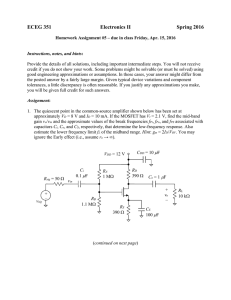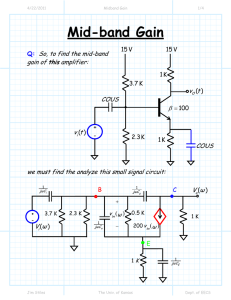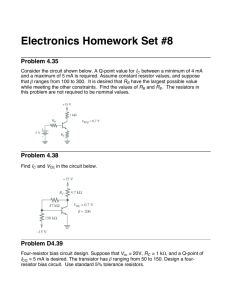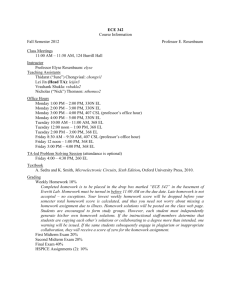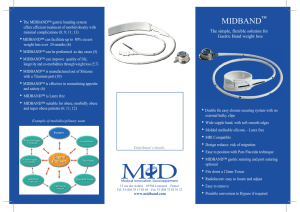EXP8: AMPLIFIERS II.
advertisement
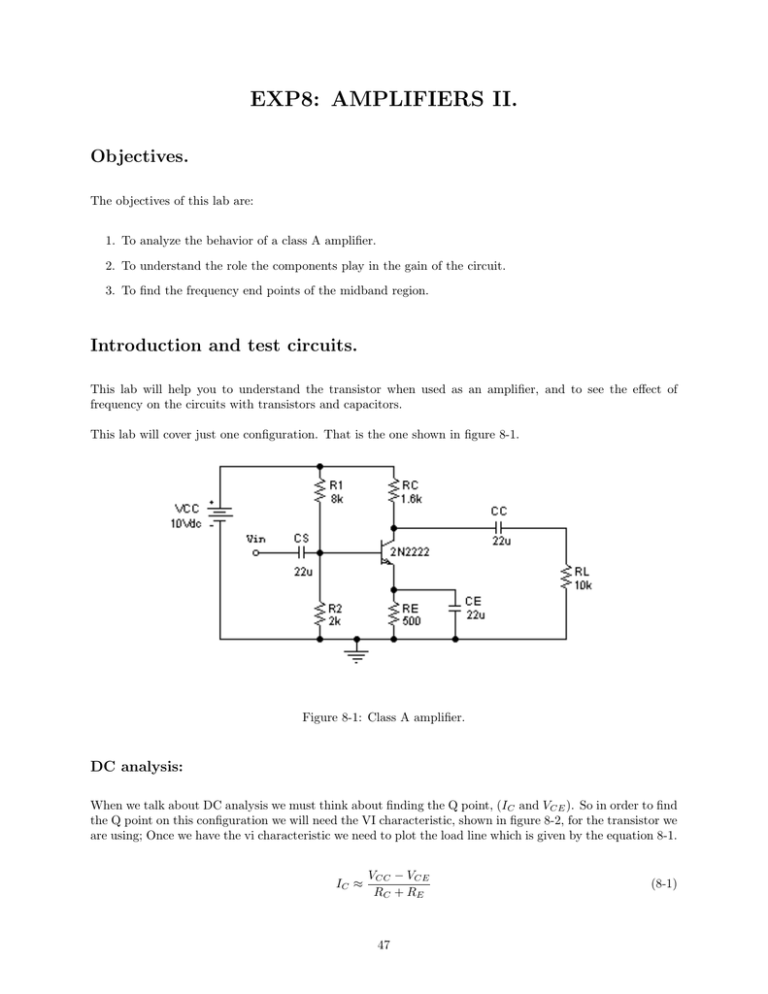
EXP8: AMPLIFIERS II. Objectives. The objectives of this lab are: 1. To analyze the behavior of a class A amplifier. 2. To understand the role the components play in the gain of the circuit. 3. To find the frequency end points of the midband region. Introduction and test circuits. This lab will help you to understand the transistor when used as an amplifier, and to see the effect of frequency on the circuits with transistors and capacitors. This lab will cover just one configuration. That is the one shown in figure 8-1. Figure 8-1: Class A amplifier. DC analysis: When we talk about DC analysis we must think about finding the Q point, (IC and VCE ). So in order to find the Q point on this configuration we will need the VI characteristic, shown in figure 8-2, for the transistor we are using; Once we have the vi characteristic we need to plot the load line which is given by the equation 8-1. IC ≈ VCC − VCE RC + RE 47 (8-1) Then we need to find the base current in order to find the VI curve we need to look in for the intersecting point, which is the Q point. To find IB use eq. 8-2. Figure 8-2: VI characteristic for the BJT 2N2222. IB = VCC h R2 R1 +R2 i − Vf i − Vf (βF + 1)RE + R1 ||R2 (8-2) If (βF + 1)RE >> R1 ||R2 then we will have the following. IB ≈ VCC h R2 R1 +R2 (βF + 1)RE (8-3) If we do not know the value for βF then we can rewrite equation 8-3 as IE ≈ VCC h R2 R1 +R2 h R2 R1 +R2 RE i − Vf (8-4) i − Vf (8-5) And if βF >> 1 then we can say that IC ≈ VCC RE Figure 8-2 shows also the load line and the Q point for the particular values shown in figure 8-1. 48 AC analysis. When we say AC analysis we must look for two things: • The midband gain. • The frequency range for the midband gain. Midband Gain: The midband gain of the amplifier must be found using the small signal model of the transistor. For this transistor we will use the small signal model shown in figure 8-3. So the circuit for the AC analysis when we look for the midband gain is the one shown in figure 8-4. Figure 8-3: Small signal model for the midband region AC analysis. The gain of this circuit is found using the equation 8-6. Gain = gm (RC ||RL ) Figure 8-4: Midband equivalent circuit using the small signal model. Frequency end points or frequency range for the midband gain: 49 (8-6) The frequency end points are defined as the points where the midband gain decreases by 3 dB. These frequency end points are harder to find, since we need to include the internal capacitance to the small signal model. And now the small signal model should look like the one in figure 8-5. So the circuit to do the analysis is now shown in figure 8-6. We will make use of the dominant pole concept to find an approximate to the low frequency end point. The high frequency end point will be measured and then we can give an approximate to the value Cπ . So the equations we will use to find the pole asociated to each capacitor are listed below. 1. For CS fS = 1 2π[RS1 + (RB ||rπ )]CS 2. For CE fE = 1 S ||RB ) ]CE 2π[RE || rπ +(R βo +1 3. For CC fC = 1 2π[RC + RL ]CC (8-7) (8-8) (8-9) Figure 8-5: Small signal model considering the capacitive effects. Once we have the frequencies use superposition of poles to find our estimate for the low frequency end point. flow = fS + fE + fC (8-10) The approximate for Cπ can be found using the following equation. But first you need to measure the high frequency end point, fπ . Cπ = 1 2π[RS ||RB ||rπ ]fπ (8-11) Preparation. Build the schematic shown in figure 8-1 using as vin the V AC part, with amplitude 1 mV, and run an ACSWEEP analysis. Trace the ratio OUTPUT/INPUT in dBs and mark the low- and high-frequency end points. 50 Figure 8-6: Equivalent circuit that can be used to find the frequency response of the amplifier. Procedure. Do the following. 1. Get the VI characteristic for the transistor using BJT IVcurves.vi. 2. Plot the load line on top of them. Use equation 8-5 to find IC and mark the Q point. 3. Now use the program BJT gm.vi using the same configuration as to get the VI curves, but now connect the upper digital multimeter to the base emitter junction, to get the transconductance curve. To find the gm value at IC first mark the point for the IC you have found and use the matrix shown on the left in the program to find the values for IC above and below it. Use those values to compute 4ic , and the corresponding Vbe values to find 4vbe . Use the following equation. gm = 4ic 4vbe (8-12) 4. Compute the amplifiers gain using eq. 8-6. 5. Build the circuit shown in figure 8-1. 6. Since this amplifier will give a big voltage gain we are not allowed to use the minimum amplitude value given by the function generator, so we will use a voltage divider to make that voltage smaller. The circuit is shown in figure 8-7. Figure 8-7: Voltage divider to be used as input for the amplifier. 7. Measure the gain at 100 Khz. and compute gm . 51 8. Now use freqlog.vi to get the bode plot of the output to input ratio. Mark the high and low frequency end points for the midban region. 9. Now replace all capacitors with 10µF capacitors and repeat last step. So at the end of the lab you need to have the following. • A plot showing the VI characteristics, the load line and the Q point, and include the measured Q point here. • A plot showing the transconductance curve. This is the curve you used to find gm . Include the measured value for gm using the amplifiers measured gain. • Two plots from freqlog.vi for the two different capacitor values used. Include here the estimated low frequency end point. Also include the estimate for the value of Cπ . Analysis. Compare the values found using equations with the measured values. Are they close? Give your own opinion why they are or are not. 52
![[1] A particular BJT operating at Ic = 2 mA has Cµ = 1 pF, Cπ = 10 pF](http://s2.studylib.net/store/data/018281219_1-ace62a2180e620d13ba4d2528f8853da-300x300.png)
